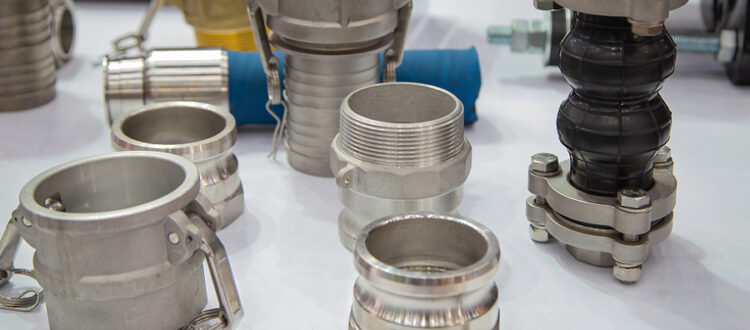Thread Types For Dry Disconnect Couplings Explained
Dry disconnect couplings play a vital role in fluid handling systems across various industries by enabling quick and safe connection or disconnection of hoses and pipelines without fluid spillage. There’s more you didn’t know about dry disconnect couplings than just their spill-proof functionality: one of the most critical yet often overlooked aspects is the thread type. Threads are essential for ensuring secure, leak-free connections between the coupling and other components in the system. The correct thread choice not only affects performance but also ensures compatibility with international standards and operational requirements.
In this article, we’ll break down the most common thread types used in dry disconnect couplings, exploring their characteristics, benefits, and key considerations to keep in mind.
1. Metric threads
Metric threads are widely used in regions that adhere to the International System of Units (SI) and are a popular choice in global manufacturing and industrial applications. Defined by ISO standards, these threads feature a consistent diameter (parallel thread) and are available in both coarse and fine pitches.
Key characteristics:
- Standardisation: Governed by ISO 261 and ISO 724, ensuring global compatibility.
- Defined geometry: Specified by two parameters, which are thread pitch (the distance between adjacent threads) and major diameter (the external diameter of the thread).
- Sealing mechanism: Typically requires auxiliary sealing methods such as O-rings or bonded seals to achieve fluid-tight performance.
Advantages:
- Global compatibility: Their standardised nature ensures interoperability between components from various manufacturers worldwide.
- High precision: Metric threads are known for tight tolerances and consistent sizing, which contribute to reliable, leak-free connections.
- Flexible sizing: Offered in a broad range of dimensions and pressure ratings, making them adaptable to many systems.
- Maintenance-friendly: Standardisation simplifies sourcing compatible parts for replacements or repairs.
Important considerations:
- Always pair metric threads with the appropriate sealing elements to ensure optimal sealing.
- Use a calibrated torque setting during installation to prevent either over-tightening, which may damage components, or under-tightening, which could lead to leaks.
2. National pipe tapered (NPT) threads
NPT threads are a staple in fluid systems across North America and are often chosen for their built-in sealing capabilities. Unlike parallel threads, NPT threads are tapered, meaning the thread diameter gradually narrows, creating a mechanical seal as the connection is tightened.
Key characteristics:
- Tapered design: Promotes tighter engagement between male and female threads, enhancing seal integrity.
- ANSI compliance: Standardised under ANSI/ASME B1.20.1, ensuring dimensional consistency across U.S.-manufactured components.
- Sealing support: Generally requires sealing compounds like PTFE (Teflon) tape or thread sealant for a fully leak-proof connection.
Advantages:
- Effective sealing: The taper and thread engagement work together to resist leaks in high-pressure environments.
- User-friendly: NPT-threaded components are straightforward to assemble and disassemble, suitable for systems requiring frequent changes.
- Wide availability: Offered in various sizes and pressure classes, accommodating diverse applications from industrial to chemical processing.
Important considerations:
- Proper sealing material is essential – never install NPT threads dry.
- Correct torque application is crucial to avoid thread damage or incomplete sealing. Use of torque guidelines or tools is recommended.
3. ISO 8434-1 Cone Connectors (24° Cone with O-Ring Seal)
The ISO 8434-1 standard defines 24-degree cone connectors equipped with metric threads and O-ring seals, commonly used in hydraulic systems demanding high-pressure performance and reliable sealing. These connectors offer a hybrid approach by combining mechanical engagement with elastomeric sealing.
Key Characteristics:
- Metric thread base: Utilises parallel metric threads for connection compatibility with ISO-based systems.
- 24° cone angle: Provides the mating surface for metal-to-metal contact, enhancing alignment and structural integrity.
- Integrated O-ring: Positioned to provide a second layer of sealing, particularly effective in preventing micro-leaks under dynamic pressures.
Advantages:
- Superior sealing performance: The combination of cone design and O-ring delivers robust, leak-free operation, even in challenging conditions.
- Standardised dimensions: Conformance to ISO 8434-1 ensures compatibility and interchangeability among compliant fittings.
- Pressure resilience: Engineered for high-pressure systems, these connectors excel in demanding hydraulic and industrial settings.
- Versatile sizing: Available in a variety of diameters to suit different installation requirements.
Important considerations:
- Inspect the O-ring before installation to confirm it is undamaged and properly seated.
- As with all threaded connections, apply the correct torque during assembly to avoid seal compromise or mechanical stress.
Conclusion
Thread selection may seem like a small detail in the context of a fluid transfer system, but it has a significant impact on performance, reliability, and safety. Whether you’re working with global standards like metric threads or specialised hydraulic connectors like ISO 8434-1, understanding each thread’s design and application requirements is essential for optimal dry disconnect coupling performance. Taking the time to match the correct thread type with the appropriate sealing methods and torque specifications will help ensure long-term, trouble-free operation.
Pharmchem Engineering offers a wide selection of high-quality, customisable dry disconnect solutions built for safety, efficiency, and durability. Avoid costly mismatches; talk to our experts today to find the perfect fit for your application and streamline your operations with confidence. Contact us now to get started.

